2023 DODGE CHALLENGER emergency towing
[x] Cancel search: emergency towingPage 7 of 300

5
IN CASE OF EMERGENCY
HAZARD WARNING FLASHERS ..................................... 199
ASSIST AND SOS MIRROR — IF EQUIPPED .................. 199
JACKING AND TIRE CHANGING ...................................... 202 Preparations For Jacking .......................................... 202
Jack Location/Spare Tire Stowage ......................... 202Jacking And Changing A Tire ................................... 203
TIRE SERVICE KIT — IF EQUIPPED ................................. 206 Alternate Tire Service Kit — If Equipped .................. 211
JUMP STARTING .............................................................. 216 Preparations For Jump Start .................................... 216
Jump Starting Procedure .......................................... 217
IF YOUR ENGINE OVERHEATS ........................................ 218
MANUAL PARK RELEASE–8–SPEED
TRANSMISSION ............................................................... 218
FREEING A STUCK VEHICLE............................................ 220
TOWING A DISABLED VEHICLE ..................................... 221 All Wheel Drive (AWD) Models — If Equipped.......... 222
Rear-Wheel Drive (RWD) Models ............................. 222
ENHANCED ACCIDENT RESPONSE
SYSTEM (EARS) ............................................................... 222
EVENT DATA RECORDER (EDR) ..................................... 222
SERVICING AND MAINTENANCE
SCHEDULED SERVICING ................................................ 223 3.6L And 5.7L Engines ............................................ 223
ENGINE COMPARTMENT ................................................ 228 3.6L Engine .............................................................. 228
5.7L Engine .............................................................. 229
Checking Oil Level .................................................... 230
Adding Washer Fluid................................................. 230Maintenance-Free Battery ....................................... 231
Pressure Washing ..................................................... 231
VEHICLE MAINTENANCE ................................................. 231 Engine Oil ................................................................. 231Engine Oil Filter ......................................................... 233Engine Air Cleaner Filter ........................................... 233Air Conditioner Maintenance ................................... 234Accessory Drive Belt Inspection............................... 235
Body Lubrication ....................................................... 235
Windshield Wiper Blades ......................................... 236
Exhaust System ........................................................ 237Cooling System ......................................................... 237Brake System ........................................................... 240
Clutch Hydraulic System —
Manual Transmission (If Equipped) ........................ 240
Manual Transmission — If Equipped ....................... 240
Automatic Transmission — If Equipped ................... 241
All-Wheel Drive (AWD) — If Equipped ...................... 241Rear Axle ................................................................... 241
Fuses ......................................................................... 242
Bulb Replacement .................................................... 250 TIRES ..................................................................................253
Tire Safety Information ............................................. 253
Tires — General Information ..................................... 261
Tire Types ................................................................... 264Spare Tires — If Equipped ......................................... 264
Wheel And Wheel Trim Care ..................................... 266
Snow Traction Devices ............................................. 267
Tire Rotation Recommendations ............................. 268
DEPARTMENT OF TRANSPORTATION UNIFORM
TIRE QUALITY GRADES ................................................... 268 Treadwear .................................................................. 268
Traction Grades ......................................................... 269
Temperature Grades ................................................. 269
VEHICLE STORAGE ...........................................................269
BODYWORK ......................................................................270 Protection From Atmospheric Agents ...................... 270
Body And Underbody Maintenance.......................... 270
Preserving The Bodywork ......................................... 270
INTERIORS ........................................................................ 271 Seats And Fabric Parts.............................................. 271Plastic And Coated Parts .......................................... 271
Leather Surfaces ....................................................... 272
Glass Surfaces .......................................................... 272
23_LA_OM_EN_USC_t.book Page 5
Page 165 of 300
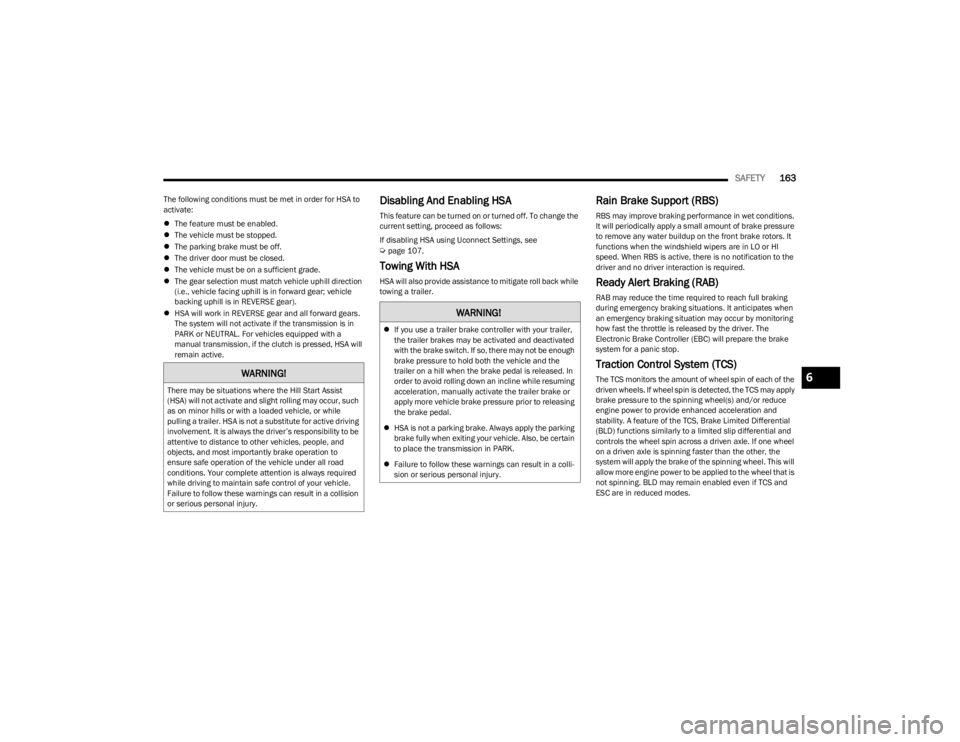
SAFETY163
The following conditions must be met in order for HSA to
activate:
The feature must be enabled.
The vehicle must be stopped.
The parking brake must be off.
The driver door must be closed.
The vehicle must be on a sufficient grade.
The gear selection must match vehicle uphill direction
(i.e., vehicle facing uphill is in forward gear; vehicle
backing uphill is in REVERSE gear).
HSA will work in REVERSE gear and all forward gears.
The system will not activate if the transmission is in
PARK or NEUTRAL. For vehicles equipped with a
manual transmission, if the clutch is pressed, HSA will
remain active.Disabling And Enabling HSA
This feature can be turned on or turned off. To change the
current setting, proceed as follows:
If disabling HSA using Uconnect Settings, see
Úpage 107.
Towing With HSA
HSA will also provide assistance to mitigate roll back while
towing a trailer.
Rain Brake Support (RBS)
RBS may improve braking performance in wet conditions.
It will periodically apply a small amount of brake pressure
to remove any water buildup on the front brake rotors. It
functions when the windshield wipers are in LO or HI
speed. When RBS is active, there is no notification to the
driver and no driver interaction is required.
Ready Alert Braking (RAB)
RAB may reduce the time required to reach full braking
during emergency braking situations. It anticipates when
an emergency braking situation may occur by monitoring
how fast the throttle is released by the driver. The
Electronic Brake Controller (EBC) will prepare the brake
system for a panic stop.
Traction Control System (TCS)
The TCS monitors the amount of wheel spin of each of the
driven wheels. If wheel spin is detected, the TCS may apply
brake pressure to the spinning wheel(s) and/or reduce
engine power to provide enhanced acceleration and
stability. A feature of the TCS, Brake Limited Differential
(BLD) functions similarly to a limited slip differential and
controls the wheel spin across a driven axle. If one wheel
on a driven axle is spinning faster than the other, the
system will apply the brake of the spinning wheel. This will
allow more engine power to be applied to the wheel that is
not spinning. BLD may remain enabled even if TCS and
ESC are in reduced modes.WARNING!
There may be situations where the Hill Start Assist
(HSA) will not activate and slight rolling may occur, such
as on minor hills or with a loaded vehicle, or while
pulling a trailer. HSA is not a substitute for active driving
involvement. It is always the driver’s responsibility to be
attentive to distance to other vehicles, people, and
objects, and most importantly brake operation to
ensure safe operation of the vehicle under all road
conditions. Your complete attention is always required
while driving to maintain safe control of your vehicle.
Failure to follow these warnings can result in a collision
or serious personal injury.
WARNING!
If you use a trailer brake controller with your trailer,
the trailer brakes may be activated and deactivated
with the brake switch. If so, there may not be enough
brake pressure to hold both the vehicle and the
trailer on a hill when the brake pedal is released. In
order to avoid rolling down an incline while resuming
acceleration, manually activate the trailer brake or
apply more vehicle brake pressure prior to releasing
the brake pedal.
HSA is not a parking brake. Always apply the parking
brake fully when exiting your vehicle. Also, be certain
to place the transmission in PARK.
Failure to follow these warnings can result in a colli -
sion or serious personal injury.
6
23_LA_OM_EN_USC_t.book Page 163
Page 223 of 300
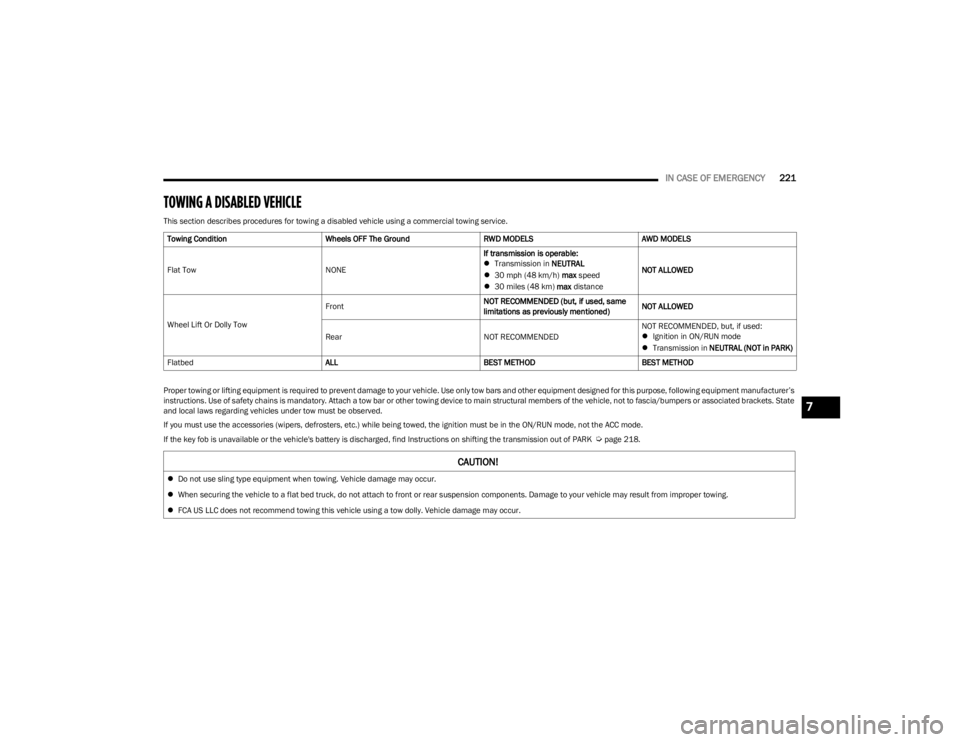
IN CASE OF EMERGENCY221
TOWING A DISABLED VEHICLE
This section describes procedures for towing a disabled vehicle using a commercial towing service.
Proper towing or lifting equipment is required to prevent damage to your vehicle. Use only tow bars and other equipment designed for this purpose, following equipment manufacturer’s
instructions. Use of safety chains is mandatory. Attach a tow bar or other towing device to main structural members of the vehicle, not to fascia/bumpers or associated brackets. State
and local laws regarding vehicles under tow must be observed.
If you must use the accessories (wipers, defrosters, etc.) while being towed, the ignition must be in the ON/RUN mode, not the ACC mode.
If the key fob is unavailable or the vehicle's battery is discharged, find Instructions on shifting the transmission out of PARK
Úpage 218.
Towing Condition
Wheels OFF The GroundRWD MODELSAWD MODELS
Flat Tow NONEIf transmission is operable:
Transmission in NEUTRAL
30 mph (48 km/h) max speed
30 miles (48 km) max distance NOT ALLOWED
Wheel Lift Or Dolly Tow Front
NOT RECOMMENDED (but, if used, same
limitations as previously mentioned)NOT ALLOWED
Rear NOT RECOMMENDEDNOT RECOMMENDED, but, if used:
Ignition in ON/RUN mode
Transmission in NEUTRAL (NOT in PARK)
Flatbed ALLBEST METHODBEST METHOD
CAUTION!
Do not use sling type equipment when towing. Vehicle damage may occur.
When securing the vehicle to a flat bed truck, do not attach to front or rear suspension components. Damage to your vehicle may result from improper towing.
FCA US LLC does not recommend towing this vehicle using a tow dolly. Vehicle damage may occur.
7
23_LA_OM_EN_USC_t.book Page 221
Page 224 of 300
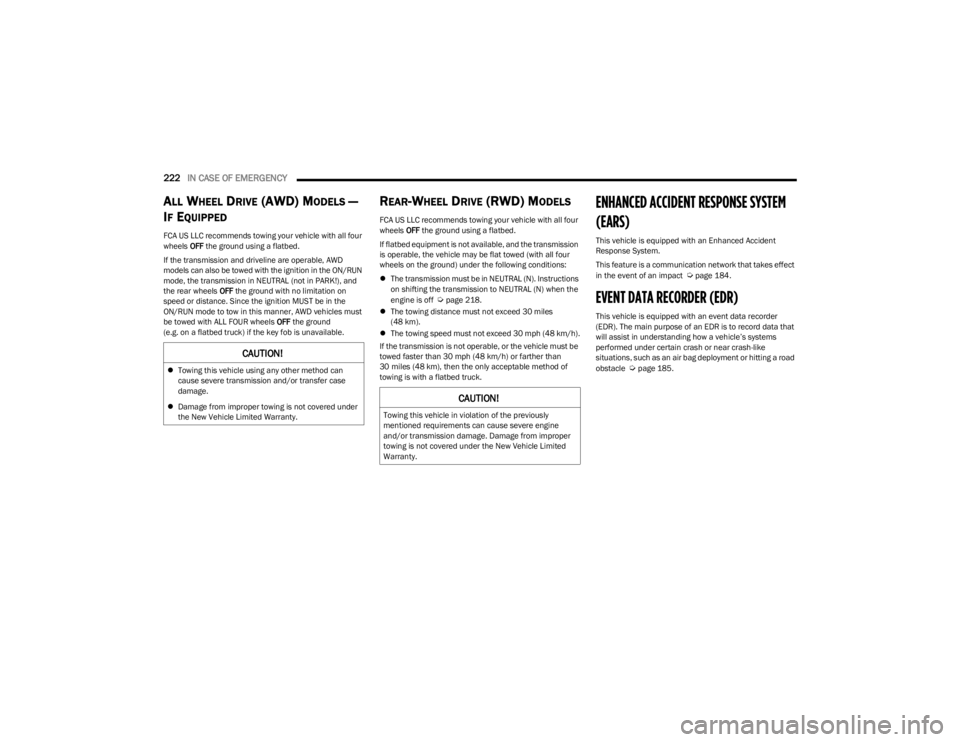
222IN CASE OF EMERGENCY
ALL WHEEL DRIVE (AWD) MODELS —
I
F EQUIPPED
FCA US LLC recommends towing your vehicle with all four
wheels OFF the ground using a flatbed.
If the transmission and driveline are operable, AWD
models can also be towed with the ignition in the ON/RUN
mode, the transmission in NEUTRAL (not in PARK!), and
the rear wheels OFF the ground with no limitation on
speed or distance. Since the ignition MUST be in the
ON/RUN mode to tow in this manner, AWD vehicles must
be towed with ALL FOUR wheels OFF the ground
(e.g. on a flatbed truck) if the key fob is unavailable.
REAR-WHEEL DRIVE (RWD) MODELS
FCA US LLC recommends towing your vehicle with all four
wheels OFF the ground using a flatbed.
If flatbed equipment is not available, and the transmission
is operable, the vehicle may be flat towed (with all four
wheels on the ground) under the following conditions:
The transmission must be in NEUTRAL (N). Instructions
on shifting the transmission to NEUTRAL (N) when the
engine is off
Úpage 218.
The towing distance must not exceed 30 miles
(48 km).
The towing speed must not exceed 30 mph (48 km/h).
If the transmission is not operable, or the vehicle must be
towed faster than 30 mph (48 km/h) or farther than 30 miles (48 km), then the only acceptable method of
towing is with a flatbed truck.
ENHANCED ACCIDENT RESPONSE SYSTEM
(EARS)
This vehicle is equipped with an Enhanced Accident
Response System.
This feature is a communication network that takes effect
in the event of an impact
Úpage 184.
EVENT DATA RECORDER (EDR)
This vehicle is equipped with an event data recorder
(EDR). The main purpose of an EDR is to record data that
will assist in understanding how a vehicle’s systems
performed under certain crash or near crash-like
situations, such as an air bag deployment or hitting a road
obstacle
Úpage 185.
CAUTION!
Towing this vehicle using any other method can
cause severe transmission and/or transfer case
damage.
Damage from improper towing is not covered under
the New Vehicle Limited Warranty.
CAUTION!
Towing this vehicle in violation of the previously
mentioned requirements can cause severe engine
and/or transmission damage. Damage from improper
towing is not covered under the New Vehicle Limited
Warranty.
23_LA_OM_EN_USC_t.book Page 222
Page 267 of 300
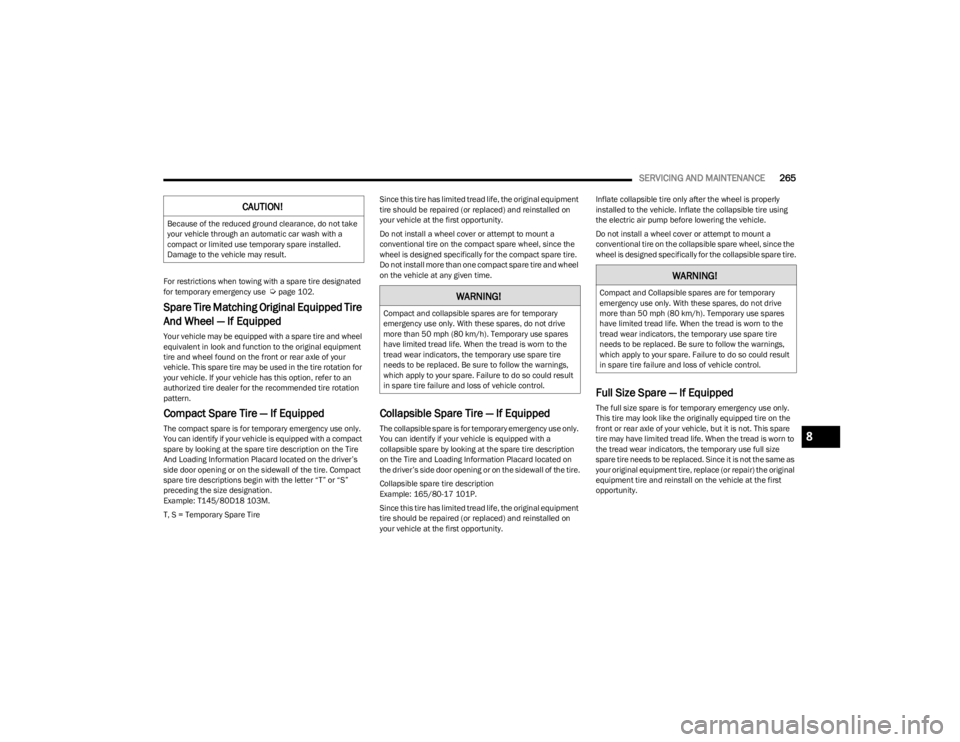
SERVICING AND MAINTENANCE265
For restrictions when towing with a spare tire designated
for temporary emergency use Úpage 102.
Spare Tire Matching Original Equipped Tire
And Wheel — If Equipped
Your vehicle may be equipped with a spare tire and wheel
equivalent in look and function to the original equipment
tire and wheel found on the front or rear axle of your
vehicle. This spare tire may be used in the tire rotation for
your vehicle. If your vehicle has this option, refer to an
authorized tire dealer for the recommended tire rotation
pattern.
Compact Spare Tire — If Equipped
The compact spare is for temporary emergency use only.
You can identify if your vehicle is equipped with a compact
spare by looking at the spare tire description on the Tire
And Loading Information Placard located on the driver’s
side door opening or on the sidewall of the tire. Compact
spare tire descriptions begin with the letter “T” or “S”
preceding the size designation.
Example: T145/80D18 103M.
T, S = Temporary Spare Tire Since this tire has limited tread life, the original equipment
tire should be repaired (or replaced) and reinstalled on
your vehicle at the first opportunity.
Do not install a wheel cover or attempt to mount a
conventional tire on the compact spare wheel, since the
wheel is designed specifically for the compact spare tire.
Do not install more than one compact spare tire and wheel
on the vehicle at any given time.
Collapsible Spare Tire — If Equipped
The collapsible spare is for temporary emergency use only.
You can identify if your vehicle is equipped with a
collapsible spare by looking at the spare tire description
on the Tire and Loading Information Placard located on
the driver’s side door opening or on the sidewall of the tire.
Collapsible spare tire description
Example: 165/80-17 101P.
Since this tire has limited tread life, the original equipment
tire should be repaired (or replaced) and reinstalled on
your vehicle at the first opportunity.Inflate collapsible tire only after the wheel is properly
installed to the vehicle. Inflate the collapsible tire using
the electric air pump before lowering the vehicle.
Do not install a wheel cover or attempt to mount a
conventional tire on the collapsible spare wheel, since the
wheel is designed specifically for the collapsible spare tire.
Full Size Spare — If Equipped
The full size spare is for temporary emergency use only.
This tire may look like the originally equipped tire on the
front or rear axle of your vehicle, but it is not. This spare
tire may have limited tread life. When the tread is worn to
the tread wear indicators, the temporary use full size
spare tire needs to be replaced. Since it is not the same as
your original equipment tire, replace (or repair) the original
equipment tire and reinstall on the vehicle at the first
opportunity.
CAUTION!
Because of the reduced ground clearance, do not take
your vehicle through an automatic car wash with a
compact or limited use temporary spare installed.
Damage to the vehicle may result.
WARNING!
Compact and collapsible spares are for temporary
emergency use only. With these spares, do not drive
more than 50 mph (80 km/h). Temporary use spares
have limited tread life. When the tread is worn to the
tread wear indicators, the temporary use spare tire
needs to be replaced. Be sure to follow the warnings,
which apply to your spare. Failure to do so could result
in spare tire failure and loss of vehicle control.
WARNING!
Compact and Collapsible spares are for temporary
emergency use only. With these spares, do not drive
more than 50 mph (80 km/h). Temporary use spares have limited tread life. When the tread is worn to the
tread wear indicators, the temporary use spare tire
needs to be replaced. Be sure to follow the warnings,
which apply to your spare. Failure to do so could result
in spare tire failure and loss of vehicle control.
8
23_LA_OM_EN_USC_t.book Page 265
Page 289 of 300

287
Driver’s Seat Back Tilt ....................................................28
DrivingThrough Flowing, Rising, Or Shallow Standing Water .................................................. 105
EElectric Brake Control System..................................... 160Anti-Lock Brake System ......................................... 159
Electronic Roll Mitigation .............................. 160
, 163
Electrical Power Outlets..................................................50 Electronic Power Distribution Center (Fuses) ............ 242
Electronic Stability Control (ESC) ................................ 161
Electronic Throttle Control Warning Light...................... 65Emergency Trunk Release.............................................. 55
Emergency, In Case Of Freeing Vehicle When Stuck .................................. 220
Jacking..................................................................... 202
Jump Starting ................................................. 216
, 217
Towing ..................................................................... 221
Emission Control System Maintenance.........................70
Engine .................................................................. 228
, 229
Air Cleaner ............................................................... 233 Break-In Recommendations ..................................... 74
Checking Oil Level .................................................. 230Compartment ................................................. 228
, 229
Compartment Identification ................................... 228 Coolant (Antifreeze) ................................................ 238
Cooling..................................................................... 237
Exhaust Gas Caution .............................................. 198
Fails To Start .............................................................. 74
Flooded, Starting ....................................................... 74
Fuel Requirements ................................................. 274 Jump Starting ................................................. 216
, 217
Oil ...........................................................231, 277, 278 Oil Filler Cap ............................................................. 228
Oil Filter ....................................................................233Oil Selection ................................................... 231
, 277
Oil Synthetic ............................................................. 232
Starting....................................................................... 71
Engine Oil Life Reset
b
............................................... 59
Enhanced Accident Response Feature ............. 184, 222
Ethanol .......................................................................... 275
Exhaust Gas Cautions ..................................................198
Exhaust System .................................................. 198
, 237
Exterior Lighting .............................................................. 39
Exterior Lights ........................................................39
, 198
FFiller Location Fuel ......................................................... 96
Filters Air Cleaner ............................................................... 233
Air Conditioning ................................................49
, 234
Engine Oil ................................................................. 233
Engine Oil Disposal..................................................233
Flashers ......................................................................... 199 Hazard Warning ....................................................... 199
Turn Signals ...............................................42
, 69, 198
Flash-To-Pass .................................................................. 41
Flooded Engine Starting ................................................. 74
Fluid Capacities ............................................................277
Fluid Leaks ....................................................................198
Fluid Level Checks Brake ........................................................................ 240
Cooling System ........................................................ 238
Engine Oil ................................................................. 230
Transfer Case .......................................................... 241 Fluid, Brake................................................................... 279
Fog Lights........................................................................ 42
Fold-Flat Seats ......................................................... 28
, 30
Forward Collision Warning ........................................... 167
Freeing A Stuck Vehicle ............................................... 220
Fuel................................................................................ 274 Additives .................................................................. 275
Clean Air .................................................................. 275
Ethanol..................................................................... 275Filler Cap (Gas Cap) .................................................. 96
Gasoline ................................................................... 274
Materials Added ...................................................... 275
Methanol ................................................................. 275
Octane Rating.................................................274
, 278
Requirements .......................................................... 274
Specifications .......................................................... 278
Tank Capacity .......................................................... 277
Fueling ............................................................................ 96 Fuses ............................................................................. 242
GGarage Door Opener (HomeLink) .................................. 36Gas Cap (Fuel Filler Cap) ............................................... 96
Gasoline, Clean Air ....................................................... 275
Gasoline, Reformulated ............................................... 275
Gear Ranges ................................................................... 79
Glass Cleaning .............................................................. 272
Gross Axle Weight Rating ........................................ 98
, 99
Gross Vehicle Weight Rating .................................. 98, 99
GVWR .............................................................................. 98
11
23_LA_OM_EN_USC_t.book Page 287
Page 294 of 300
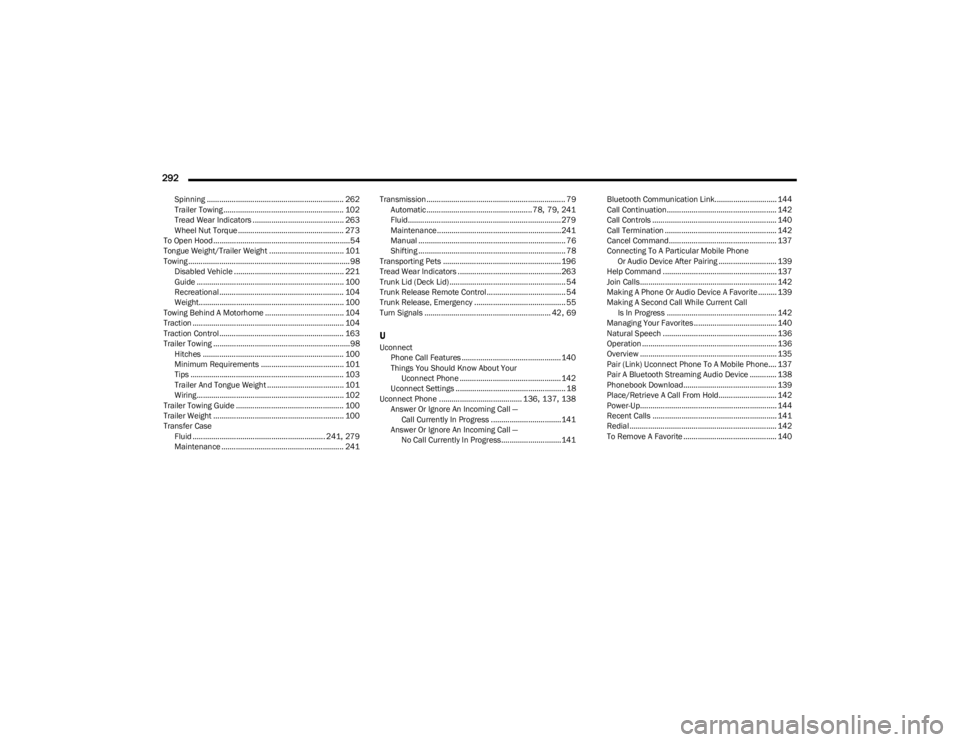
292
Spinning .................................................................. 262
Trailer Towing .......................................................... 102
Tread Wear Indicators ............................................ 263
Wheel Nut Torque ................................................... 273
To Open Hood..................................................................54
Tongue Weight/Trailer Weight .................................... 101
Towing .............................................................................. 98 Disabled Vehicle ..................................................... 221
Guide ....................................................................... 100Recreational ............................................................ 104
Weight...................................................................... 100
Towing Behind A Motorhome ...................................... 104
Traction ......................................................................... 104
Traction Control............................................................ 163
Trailer Towing ..................................................................98 Hitches .................................................................... 100
Minimum Requirements ........................................ 101
Tips .......................................................................... 103
Trailer And Tongue Weight ..................................... 101
Wiring....................................................................... 102
Trailer Towing Guide .................................................... 100
Trailer Weight ............................................................... 100
Transfer Case Fluid ................................................................ 241
, 279
Maintenance ........................................................... 241 Transmission................................................................... 79
Automatic ................................................... 78
, 79, 241
Fluid.......................................................................... 279 Maintenance............................................................241Manual ....................................................................... 76
Shifting ....................................................................... 78
Transporting Pets ......................................................... 196
Tread Wear Indicators ..................................................263
Trunk Lid (Deck Lid)........................................................ 54
Trunk Release Remote Control...................................... 54 Trunk Release, Emergency ............................................ 55
Turn Signals ............................................................. 42
, 69
UUconnect Phone Call Features ................................................ 140
Things You Should Know About YourUconnect Phone ................................................. 142
Uconnect Settings ..................................................... 18
Uconnect Phone ........................................ 136
, 137, 138
Answer Or Ignore An Incoming Call — Call Currently In Progress ..................................141
Answer Or Ignore An Incoming Call — No Call Currently In Progress............................. 141 Bluetooth Communication Link.............................. 144
Call Continuation..................................................... 142
Call Controls ............................................................ 140
Call Termination ...................................................... 142
Cancel Command.................................................... 137
Connecting To A Particular Mobile Phone
Or Audio Device After Pairing ............................ 139
Help Command ....................................................... 137 Join Calls.................................................................. 142
Making A Phone Or Audio Device A Favorite ......... 139
Making A Second Call While Current Call Is In Progress ..................................................... 142
Managing Your Favorites ........................................ 140 Natural Speech ....................................................... 136Operation ................................................................. 136
Overview .................................................................. 135
Pair (Link) Uconnect Phone To A Mobile Phone.... 137
Pair A Bluetooth Streaming Audio Device ............. 138Phonebook Download............................................. 139
Place/Retrieve A Call From Hold............................ 142
Power-Up.................................................................. 144
Recent Calls ............................................................ 141
Redial ....................................................................... 142
To Remove A Favorite ............................................. 140
23_LA_OM_EN_USC_t.book Page 292